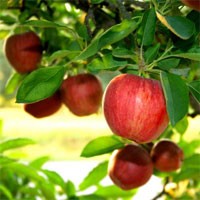Arizona Vegetable & Fruit Gardening
For The Arizona Desert Environment.
Pictures, Photos, Images
Descriptions, Information, & Reviews.
We Are Proud Of Our SafeSurf Rating!
Click On The Item For A More Detailed Look. No Obligation!
| Cameo, Malus domestica "Cameo"Apple Tree. Semi Dwarf About 13 Feet High. 4 Year Old. Photo Taken July 02, 2011 In Yarnell, Arizona. |
|---|
| Gala, Malus "Gala" Apple Tree. Dwarf About 4 Feet High. 4 Year Old. Photo Taken July 02, 2011 In Yarnell, Arizona. |
|---|
Here Are Some Photos Of Great Tasting Apples That Grow Well In Arizona!
| Ripe Cameo Apple Fruit. From Cameo, Malus domestica "Cameo"Apple Tree. | Ripe Gala Apple Fruit. From Gala, Malus 'Gala' Apple Tree. |
|---|---|
| Ripe Fuji Apple Fruit. From Fuji, Malus 'Fuji' Apple Tree. | Ripe Granny Smith Apple Fruit. From Granny Smith, Malus 'Granny Smith' Apple Tree. |
 | 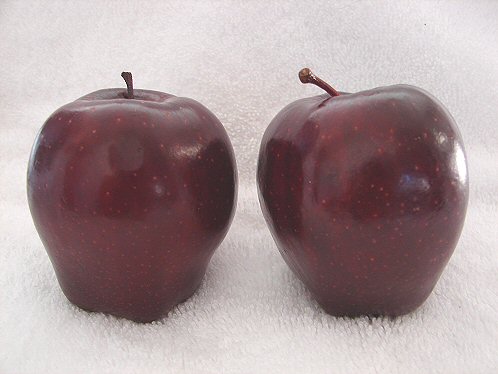 |
| Ripe "Royal Gala" Apple Fruit. From Cultigen Of A Sport Of The Gala Apple In The 1970's. | Ripe "Red Delicious" Apple Fruit. From Malus 'Red Delicious' Apple Tree. |
Click On The Item For A More Detailed Look. No Obligation!
| Blooming Cameo Apple Tree. April 10, 2012. Cameo, Malus domestica "Cameo"Apple Tree. | Blooming Gala Apple Tree. April 10, 2012. Gala, Malus 'Gala' Apple Tree. |
|---|---|
| Blossoms Cameo Apple Tree. April 10, 2012. Cameo, Malus domestica "Cameo"Apple Tree. | Blossoms Cameo Apple Tree. April 10, 2012. Cameo, Malus domestica "Cameo"Apple Tree. |
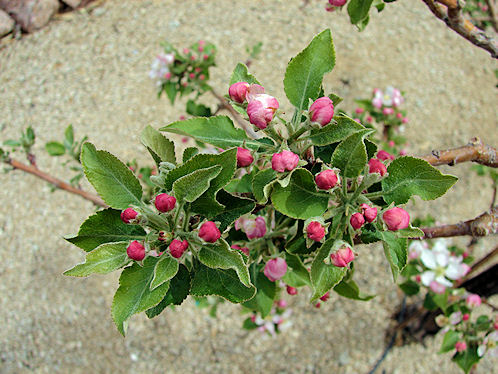 | 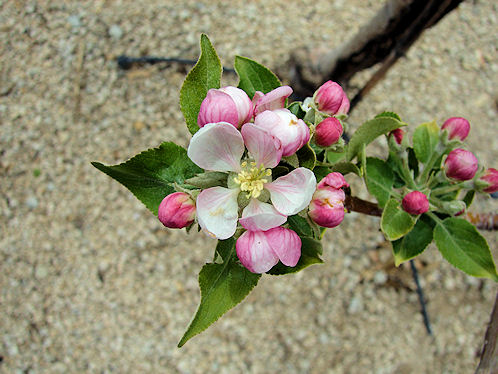 |
| Blossoms Gala Apple Tree. April 10, 2012. Gala, Malus 'Gala' Apple Tree. | Blossoms Gala Apple Tree. April 10, 2012. Gala, Malus 'Gala' Apple Tree. |
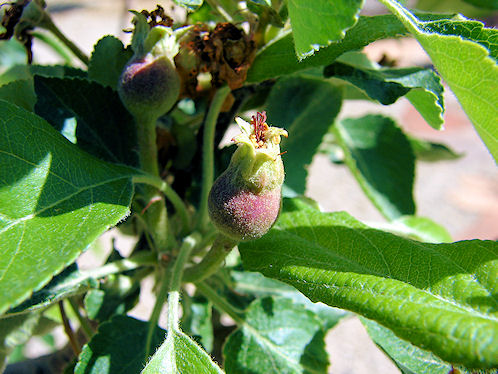 | |
| Immature Fruit Buds. Gala Apple Tree. April 27, 2012. Gala, Malus 'Gala' Apple Tree. | Immature Fruit Buds. Gala Apple Tree. April 27, 2012. Gala, Malus 'Gala' Apple Tree. |
| Blooming Fuji Apple Tree. April 10, 2012. Fuji, Malus 'Fuji' Apple Tree. | Blossoms Fuji Apple Tree. April 10, 2012. Fuji, Malus 'Fuji' Apple Tree. |
| Flower Buds Fuji Apple Tree. April 10, 2012. Fuji, Malus 'Fuji' Apple Tree. | Flowers Fuji Apple Tree. April 10, 2012. Fuji, Malus 'Fuji' Apple Tree. |
| Apple Fruit Should Be Thinned Out After They Are About The Diameter Of A Dime Apple Fruit Thinning Guide Example Photo. Unthinned Fuji Apple Fruit. April 28, 2012. Fuji, Malus 'Fuji' Apple Tree. | Apple Fruit Should Be Thinned Out After They Are About The Diameter Of A Dime Apple Fruit Thinning Guide Example Photo. Thinned Fuji Apple Fruit. April 28, 2012. Fuji, Malus 'Fuji' Apple Tree. |
| Unripe Cameo Apple Fruit. July 02, 2011. Cameo, Malus domestica "Cameo"Apple Tree. | Unripe Cameo Apple Fruit. July 02, 2011. Cameo, Malus domestica "Cameo"Apple Tree. |
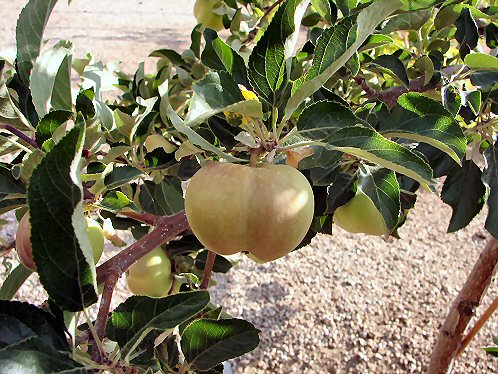 | |
| Unripe Gala Apple Fruit. July 02, 2011. Gala, Malus 'Gala' Apple Tree. | Unripe Gala Apple Fruit. July 02, 2011. Gala, Malus 'Gala' Apple Tree. |
Apple Tree We wish to thank Wikipedia, the free encyclopedia for some of the information on this page. We share images and information with Wikipedia. The apple is the pomaceous fruit or "pome" of the apple tree, species Malus domestica in the rose family (Rosaceae). It is one of the most widely cultivated tree fruits, and the most widely known of the many members of the genus Malus that are used by humans. In botany, a "pome" (named after the Latin word for fruit: pomum) is a type of fruit produced by flowering plants in the subfamily Maloideae of the family Rosaceae. A pome is an accessory fruit composed of one or more carpels surrounded by accessory tissue. The accessory tissue is interpreted by some specialists as an extension of the receptacle and is then referred to as "fruit cortex", and by others as a fused hypanthium or "torus." In layman's terms, "it is the most edible part of this fruit". Although the exocarp, mesocarp, and endocarp of some of the other fruit types look very much like the skin, flesh, and core respectively of a pome, they are actually parts of the carpel. The exocarp and mesocarp of a pome may be fleshy and difficult to distinguish from one another and from the hypanthial tissue. The endocarp forms a leathery or stony case around the seed, and corresponds to what is commonly called the core. The shriveled remains of the sepals, style and stamens can sometimes be seen at the end of a pome opposite the stem, and the ovary is often called inferior in these flowers. The apple tree is thought to have originated in Western Asia, perhaps in eastern Turkey, where its wild ancestor, the Alma, is still found today. There are more than 7,500 known cultivars of apples, resulting in a large range of desired characteristics. Cultivars vary in their yield and the ultimate size of the tree, even when grown on the same rootstock. The apple tree is thought to be the earliest tree to be cultivated, and its fruits have been improved through selection over thousands of years. Alexander the Great is credited with finding dwarfed apples in Kazakhstan in Asia in 328 BCE. It is said that he brought them back to Macedonia and that they may have been the progenitors of the dwarfing root stocks. The apple forms a tree that is small and deciduous, reaching between 9.8 to 39 feet tall, with a broad, often densely wide branching crown. The crown is either spherical or ovoid. It's shoots remain pubescent for a long time. It's buds are ovoid-conical. The apple tree leaves are alternate, simple, with a serrated margin, 5-10 cm long, ovoid, with pointed peak, and a rounded or slightly heart-shaped base, crenate-serrate, pubescent. It's leafstalk is no more than 1/3 of the blade length. The corolla of the apple is it's inner set of leaflike parts lying just within the calyx and composed of petals The 5 petals of it's flower or it's corolla is considered perfect, it is white or pinkish in color, and 0.98 to 1.4 inches in diameter. It usually has red stamens that produce copious pollen, and they have a half-inferior ovary Generally speaking, the apple tree fruits usually differ in shape, size (usually more than 1 1/4 inches in diameter) (some up to 3 to 4 inches in diameter) , color, texture, time of maturity, and storage quality. It's fruits can have a sour, sour-sweet or sweet taste. The average weight of it's fruit is about 150-160 g, but sometimes reaches 600 g (Antonovka Polutorafuntovaja) and even 900 g (Aport Alexandr). The center of it's fruit contains five carpels arranged star-like, each containing one to two (rarely three) seeds. The fruit is considered a globose pome. Generally speaking apple trees produce flowers in April - June, they bear fruit in August - October, sometimes through December. Generally speaking apple trees grow and bear good fruit on loamy and sandy loam soils, as well as on sandy soils with the addition of organic fertilizations. Normally their growth and development on saline, swampy and peaty soils is not good. Their life expectancy averages about 60 - 70 years. Large-fruited varieties, as a rule, grow better in the southern USA. Apple trees are usually offered by nurseries in 3 distinct sizes. Dwarf varieties get to be 5 to 8 feet tall, semi-dwarf varieties are usually 12 to 16 feet tall, and standard varieties get between 20 and 30 feet tall. The size variations allows for apple trees to be planted in small spaces and easier harvesting. When selecting an apple tree, the climatic zone the tree is going to grow in is an important factor. When selecting an apple tree, after you consider where it will grow best, consider it's taste. Fresh fruit is simply better and tastier than the bin stored commercial apples that are sold in supermarkets. After all, it's taste is the most important thing to you!
Here Are Some Of The More Popular Eating Types Of Apples:
The Anna Apple Tree, Malus domestica 'Anna': Root Stock, Semi-Dwarf: M-111, is an apple tree that produces fruit that is attractive, medium sized, bright red, and has firm, white, juicy flesh that is sweet and somewhat spicy. Anna Apple Tree, Malus domestica 'Anna', is a decorative tree that produces edible fruit early in the summer. It�s especially well-suited for warmer climates and would do well in a sunny location near your home�s windows, lining your driveway�or anywhere you�re sure to enjoy every minute of its transition from flower to fruit. There�s nothing like the smell of apple blossoms heralding the spring, and your Anna Apple tree will bring that delicate aroma to you early in the season when its branches burst forth in a profusion of petite, pink-tinted blossoms. Anna�s display will be a sight to see in your yard each spring, followed by yet another exciting vision as those flowers transition to delicious fruit. The green-tinted, yellow skin of your Anna apple sports a hearty, red blush and the flesh is a taste sensation right off your tree! In its early stages, Anna has been compared to a Grammy Smith. However, as it ripens, Anna increases in sweetness. Anna apples even store well for one to two months (depending upon the storage method), and are terrific used for such culinary delights as apple pancakes, apple pie and a large variety of other tasty treats. Anna Apple Tree will grow up to 30 feet tall with a 30 foot spread. It was developed in Israel and has a low chill requirement that allows it to be grown in warmer climates, where growing apple trees can sometimes be problematic. It will begin to fruit at an early age. It has a semi-spreading nature and is self-fertile (although having another pollinator, such as Dorsett nearby is recommended for optimal performance). Apple trees are always a welcomed sight at any home, and Anna is an exceptional choice, (especially if you live in a warmer climate). Early to flower and fruit, the Anna Apple tree won�t make you wait long before you�re enjoying the many benefits it has to offer.
The distinctive dark red skin encases a high quality fruit even where summer nights are warm. Use this apple for dessert and cooking. This is a great variety to add in a cider blend, providing a high acid, spicy flavor. They have an excellent storage life. They keep for many months. Arkansas Black blooms in mid-season and is a great pollinator for early blooming apple varieties, varieties blooming in the middle of the season, and varieties blooming late in the season. The Arkansas Black apple tree requires a pollinator in order to bear fruit. We suggest the following other apple trees as pollinators: Golden Delicious Apple, Granny Smith Apple and Dolgo Crabapple. Grows Best In Zones Zones: 5 - 9.
Braeburn apples are an old-fashioned sweet apple with a smooth and crisp texture. It's great for snacks and salads. It is a late season apple with a long storage life. Its eating qualities make it adaptable for cooking as well as fresh use. Grows Best In Zones Zones: 4 - 10.
There is nice color variety in this medium-sized apple, from yellow-green with red streaks to mostly red, and it is America�s first choice for fresh use in salads, or just eating out of hand. It�s also the latest-ripening southern apple and is a prolific producer, bearing 8-10 bushels of fruit from just one tree. Fuji's need full sun and well-drained soil in a climate where the winters are relatively mild. The fruit takes about 160 days to ripen, and then another 300-500 chill hours for dormancy. Fuji's are self fertile however you will achieve better quality fruit if you allow it to be pollinated by another tree. Fuji's bloom in mid to late spring and can be planted with other late-season varieties such as Gala and Granny Smith. Deer will help keep fallen fruit off the ground. This is one of our best producers in Yarnell, Arizona. Grows Best In Zones Zones: 6 - 9. Yarnell is Zone 8a.
It is aromatic with a very sweet flavor and it has a crisp and firm texture. The Gala ripens early and stores very well (shelf life-6 months in regular storage). The Gala, a fresh fruit delight, is very much in demand for fresh salads and it's got the mild flavor that "picky eaters" prefer and a striking bright yellow-red color that attracts the eye! A very good tasting close relative of the Gala is the "Royal Gala," which is a cultigen made from a sport of the Gala apple in the 1970's. It is a pink-red dessert apple and is therefore usually eaten fresh. Royal Galas are usually harvested in early to late February in the southern hemisphere. This is also one of our best producers in Yarnell, Arizona. Grows Best In Zones Zones: 4 - 10. Yarnell is Zone 8a.
By reducing the emphasis on the red color � which tends to produce a thick-skinned, mealy apple � they were able to keep the skin ultra thin, the flavor a perfect combination of sweet and tart, and the flesh extra-crunchy. It all started when Darrel Caudle planted a new apple tree in his orchard in Dryden, WA, near Wenatchee. As the tree grew, he noticed that the apples were different from all the others. Instead of the solid color he was expecting, they were striped red with a cream background. One taste of the flavorful, crunchy flesh and the tender, thin skin of this orchard interloper and he knew for absolute sure that this was a completely different apple than the others in his orchard! Little did Darrel imagine at the time that the fruit from his �chance seedling� would grow into an apple so revolutionary that he would later register it for a trademark and name it �Cameo.� Today all Cameo trees are descended from Darrel�s seedling, which is still producing fruit in his hillside orchard. This family of trees is an industry celebrity, drawing apple aficionados, growers and nurserymen from all over the world to see the very first Cameo planting that started the whole new variety that would become America�s new favorite apple. Its parentage is uncertain; it may be a cross between a Red Delicious and a Golden Delicious, since it was found near orchards of those fruits; it also appears similar to the original Delicious cultivar. It is bright red striped over creamy orange, firm and crisp with an aromatic flavor. It is rapidly becoming a favorite, and is now among the top ten most grown apples in Washington Cooking Light magazine ranked Cameo as one of the best apple varieties in its 2002 Apple Pageant! We have two Semi - Dwarf Cameo trees in our garden in Yarnell, Arizona and they never fail to produce wonderful, delicious apples! Grows Best In Zones Zones: 4 - 8. Yarnell is Zone 8a.
The tree is open and spreading, easy to trim and train, and will produce heavy annual yields if properly thinned. It blooms mid-late season, ripens in early September, then needs 600 to 700 chill hours. The apple�s firm white flesh retains its shape when baked/cooked, but it�s also a favorite fresh-eating apple because it�s so sweet and crisp. The skin is very thin, meaning you can often skip peeling chores altogether. Plant the tree in average well-drained soil, out of frost pockets, in full sun. This is a self-fruitful tree however the best fruit is produced with a pollinator. The best choices: a Crabapple or a Red Delicious; in turn, Golden Delicious is an excellent pollinator for other apple trees. Grows Best In Zones Zones: 5 - 10.
Granny Smith apples ripen and are ready for picking in late October or early November. Grows Best In Zones: 6 - 9.
Pick your apples frequently because they have uneven ripening. This can be somewhat controlled by heavy pruning. The Red Gravenstein is a hardy variety and can withstand difficult conditions. It requires pollination from another variety: Empire, Fuji, Gala, or Red Delicious. Grows Best In Zones Zones: 2 - 9.
It has medium to large golden to greenish fruit with a very smooth finish and reddish bronze blush. The Haralson has a round-conic shape. It has a red color and large, moderately conspicuous dots. Haralson apples are crisp and juicy, having a tart flavor. They are good for eating, cooking, and are an excellent choice for pies. The skin is medium-tough, and the stem is medium. Its flavor is sweeter and more bland than Golden Delicious. High quality and superior storage qualities since it can be stored into March. It often bears fruit the first year after planting. Plant about a month after the first killing frost in the fall or about a month before the last killing frost in the spring. Select a planting site that has good air, drainage, full sunlight and deep, well drained soil. Grows Best In Zones Zones: 2 - 7.
The flavor is sub-acid and ranges from mild and well-balanced to strongly aromatic, depending on the degree of maturity. Great eating apple with its subacid flavor. Develops its full aromatic flavor if left on the tree until mid October. The Honeycrisp apple is a high quality apple which keeps well for 5-6 months in common storage. The tree is one of the most vigorous and hardy of apple trees, showing little damage at -40 degrees. Needs to be thinned heavily. Suggested pollinators are Gala, Granny Smith, Empire, McIntosh and Red Delicious. Not pollinated by Gravenstein. Grows Best In Zones: 3 - 8.
The tree is handsome, sturdy, vigorous and spreading; annually productive. The apples ripen from mid-September to late October, depending on the location. This apple needs 700-800 hours of chilling. It will store in refrigerator for three months. Pollinated by Fuji, Gala, Granny Smith or Red Delicious, but not Golden Delicious. Grows Best In Zones: 5 - 8.
The flavor is subacid and good. 'Liberty' is considered to be primarily a dessert apple. It makes an excellent applesauce if the skin is left on. Liberty Apple is a new disease resistant apple, and the name 'Liberty' denotes the freedom from disease. Since it is not resistant to insects, spraying or other means of insect control must still be used. Plant about a month after the first killing frost in the fall or about a month before the last killing frost in the spring. Select a planting site that has good air, drainage, full sunlight and deep, well drained soil. Grows Best In Zones: 4 - 7.
It's a favorite apple for eating out of hand but also is widely used in salads, sauces, pies. It is a mainstay in fresh cider and an all-time favorite for fresh eating and salads. It has a large fruit and is used in juice, pies, and eating raw. The McIntosh is partly self-fruitful, or suggested pollinators are Red Delicious, Gala, or any other apple tree. Grows Best In Zones: 4 - 7.
This apple matures in mid-season and is very productive, vigorous tree. Suggested pollinators are Fuji, Granny Smith and Beverly Hills. Grows Best In Zones: 5 - 8.
The Mutsu apple is also known as Crispin. This apple is vigorous, fairly early, and the fruit is large and oblong shaped. It is excellent for fresh eating, sauces, pies, and baking. This apple stores and keeps well. Grows Best In Zones: 4 - 8.
Northern Spy is a very large, upright, vigorous grower, and productive. It tends to bear biennially. It blooms late in the season and takes about 12 years to bear fruit. Ripens in late October. Needs a pollinator such as Golden Delicious. Grows Best In Zones: 4 - 7.
An apple tree especially for hot climates! It is large, crisp, and sweet-tart, with a pretty pink blush, over its golden-yellow peel. Many people think the taste is similar to � but better than � a Granny Smith. It�s good for eating, baking and canning. Pink Lady� does not russet, and is resistant to apple scab. A added bonus: it won�t turn brown after slicing. Locate your apple trees on a site with full to part sun, and moist, average soil with good drainage. It doesn�t need a pollinator, but it does need a long season to ripen; harvest is from late September through early October. Grows Best In Zones: 6 - 9.
Pink Pearl apples ripen in late August to mid-September. Suggested pollinators are any other apple tree or crabapple tree. Grows Best In Zones: 4 - 8.
Red Delicious apples look great for a long time so they are the favored choice for holiday centerpieces and wreaths. The fruit keeps fresh very well and can be found year around in stores. Red Delicious apples have firm, white or cream white flesh that is juicy, aromatic, sweet tasting. The heart shaped fruit is bright red and sometimes exhibits some red striping. It is crunchy with a mildly sweet flavor. They are best eaten raw because of their thick skin. The Red Delicious is widely used in salads. Suggested pollinators are Granny Smith, Liberty, Golden Delicious, Fuji and Gala. Grows Best In Zones: 4 - 7.
Red Jonathan is a round to flat, conical, medium shaped apple. Its skin is bright red with a stripe over 50�75% of its surface. Red Jonathan has a crisp flesh, that is sweet and juicy with a tang. Refrigerated storage time: 120 days. Grows Best In Zones: 4 - 8.
It does harvest early like the Red Delicious. It keeps several months and has a lesser tendency to premature drop like the McIntosh. The estimated chilling time is 800-1000 hours. It is resistant to scab, mildew and fireblight. Spartan is a heavy bearing tree, winter hardy and precocious. It is self-fruitful, but a larger crop is produced if cross-pollinated by Lodi, Wealthy, or Liberty. Grows Best In Zones: 4 - 8.
The Spitzenburg Apple has firm, crisp, fine grained, with a rich, aromatic, renowned flavor. Its size is medium to large, with round-conical, orangish fruit with tough skin. The flesh is tinged yellow, firm, aromatic, and complex in flavor; a perfect balance between sharp and sweet. Spitzenburg ripens in October and hangs on until November. This apple improves with storage and is best at Christmas time. The tree has a slender growth habit with long willowy limbs. A pollinator is required by mid-season blooming apples (not pollinated by Gravenstein), and it is hardy in Zones 4-8. Uses: as fresh eating or as a dessert, cooking (puree, applesauce, apple butter), and baking. Grows Best In Zones: 4 - 8.
Juicy and tart, the Winesap apple has a crisp, yellowish flesh covered with a deep red skin. This all-purpose apple has good keeping qualities. The fruit is good sized. The flesh is tinged with yellow and sometimes red veins run through it. It is a firm, rather coarse, moderately crisp apple with a sprightly, medium acid taste. It is resistant to russeting. This is a pollen sterile tree and requires a pollinator. Suggested pollinators are Red or Golden Delicious, Fuji, Gala and Liberty. Grows Best In Zones: 5 - 8.
The Wolf River apple is scab and mildew resistant and very winter hardy. An old variety, it is long lived and ripens mid-September to early October in Zone 5. Wolf River is a midseason apple grown best in northern climates. Plant about a month after the first killing frost in the fall or about a month before the last killing frost in the spring. Select a planting site that has good air, drainage, full sunlight and deep, well drained soil. Grows Best In Zones: 3 - 9.
This vigorous tree is generally late blooming, and it needs full sun, well-drained soil, and moderate fertility. It is best to thin fruit to maximize quality and size. Yellow Newton stores well and is self fertile. For peak flavor and acid/sugar balance, wait until harvest when cheeks are yellowish-green. Grows Best In Zones: 5 - 8.
The Yellow Transparent tree is very upright, precocious, and productive, so therefore, is a very heavy producer. It is an early yellow apple, ripening the first week in JulyPick before maturity for better storage life. Harvest time is mid-June to July. Careful early training, annual pruning and shaping are required to insure a healthy and productive tree. It is scab resistant. Plant about a month after the first killing frost in the fall or about a month before the last killing frost in the spring. Select a planting site that has good air, drainage, full sunlight and deep, well drained soil. Grows Best In Zones: 2 - 7.
Here are some links to the Nature Hills Nursery; where you can order some of their very high quality Apple Trees. If you click, there is no obligation to buy! You will leave delange.org. NOTE: These are High Quality Speciality Trees. They are not usually found at the typical Big Box Stores!
Planting Apple Trees In Arizona:
Decide on the site for your tree/s some months in advance of planting. NOTE: Almost of the apple trees sold are grafted. Therefore there will be a bud union on every tree. The bud union is the location where the scion meets the rootstock. The bud union should not be buried in the ground when planting. ALWAYS keep the bud union about 2 inches above the ground when planting. 1. Decide on which tree to plant. Fruit trees that thrive in Arizona include the apple, cherry, apricot, fig, nectarine, peach, pear, Asian pear, persimmon, Asian plum and Japanese plum. Although there are general guidelines that apply to any fruit tree growing in Arizona, you should also learn the specific requirements of the tree you plant. 2. Choose a nursery tree. The University of Arizona College of Agriculture and Life Sciences recommends you buy a year-old tree with a trunk that's � to � inches in diameter. Select a fruit tree without broken branches or other signs of injury. If you can, check the roots while still in the nursery or soon after you take the tree home. Save the receipt in case you have to exchange it. Roots with soft spots, bugs, mildew and other irregularities are diseased and can't support a tree's development. In the arid Arizona climate, roots should also be irrigated frequently. At the nursery, touch the soil to verify it's moist. If the tree is bare-root, check that the root ball is in a moist medium. 3. Find a sunny planting site with well-drained soil. Test drainage by digging a hole as deep and wide as the tree's root ball. Then, put 5 gallons of water in it. One hour later, fill the hole with water again. If the soil has absorbed the 10 gallons of water within 24 hours, your soil drains well. Let most of the moisture evaporate before you plant your fruit tree. 4. Schedule the planting. In Arizona, plant bare-root fruit trees in February or March. Transplant container trees in September or October. Most fruit trees for sale have bare roots. Keep store-bought trees in the shade and their soil moist until you're ready to plant them. 5, Enlarge the planting hole you made in Step 3 to five times the width of the root ball, but keep it at the same depth. On the bottom, pile soil in the center to form a small mound in the hole. 6. Loosen and cut broken or discolored roots. Trim longer roots to the same size as the others. 7. Put the tree in the hole with the center of the root ball on the mound. Spread the roots down and around it. Backfill the hole with the topsoil you dug out. 8. Water the soil thoroughly and add a 4-inch layer of mulch around the base of the tree. Continue to water every two days during the growing season, giving your tree about 5 gallons of water a week. The University of Arizona Extension Service also recommends you paint the tree trunk with white latex paint to protect it from sunburn. 9. Prune your fruit tree right after you plant it. Cut the top 1/3 and train it into the shape best for the type of tree you have. For example, use the central leader method for apples and pears, and open center if you have peaches and nectarines. Your nursery or extension office offers advice on the right training method for your fruit tree. 10. Fertilize the soil when new growth begins after planting and in the beginning of every growing season, February to March in Arizona. The type and amount of fertilizer depends on the tree you have, but all fruit trees need nitrogen. In addition, spray a formula of chelated zinc and iron on the leaves. 11. Control pests and treat disease. In Arizona, the codling moth and peach tree borers are among about a dozen common insects that attack fruit trees. Diseases include fireblight, brown and crown rot, and powdery mildew. If something is affecting your tree's appearance and development, get help from your local extension office in identifying the problem and treating it. 12. Thin the fruit to keep branches from breaking under heavy weight and to improve fruit quality. Depending on the tree, you'll either prune the flowers as they bloom or the fruit as they mature, spacing them about 6 inches apart.
Pruning Apple Trees:
Proper training and pruning of fruit trees is essential to the development of a strong tree framework that will support fruit production. Properly shaped trees will yield high-quality fruit much sooner and will live significantly longer. Regular pruning and training will also maximize light penetration to the developing flower buds and fruit. Additionally, a well-shaped tree canopy permits adequate air movement through the tree, which promotes rapid drying to minimize pest problems.
Central Leader Trees:
Newly Planted Trees:
Scaffold Training:
Dormant Pruning vs. Summer Pruning:
Summer pruning will devigorate the tree and cause it to grow less in that growing season. Remove all undesirable branches directly across from one another on the central leader when they are 3 to 4 inches long. Also, select lateral branches that are spaced uniformly around the leader to prevent crowding as the limbs grow in diameter. Once the tree has filled its allotted space, lateral branches will need to be cut back to their desired length during the summer to devigorate the tree and prevent further growth, not during the dormant season. Ask your County Extension Center for information on the best way to prune your apple tree.
Fruit Thinning:
At first thought, it seems strange to thin out what appear to be perfectly good fruit. But, keep on reading. Apple trees often set a heavier crop of fruit than the limbs can withstand. To ensure good fruit size, return bloom for the following year, and to prevent tree breakage, it is necessary to thin the fruit. Every apple blossom results in a bloom cluster of 5 to 6 blossoms. Apples should be thinned when they are about the size of a dime in diameter. It is recommended to thin fruit, after the natural June fruit drop; which happens during May in most of Arizona. We have done it either before or after the fruit drop, with success, either way. When "thinning," cut & throw away, the poor quality looking fruit buds. Save the best ones. Cut off enough fruit so that the remaining apples are spaced 4 to 6 inches apart, and leave only one fruit per cluster. It may seem like very few fruit remain, but you will harvest higher-quality fruit, potentially reduce insect and disease problems, and increase the chances for a full crop the next season. Some commercial growers even say they see an increased amount of fruit by weight, in the long haul! They all claim to have better quality fruit to sell. We would have to agree that the fruit quality is better and we seem to get a good amount of fruit, by weight. We have shown an example, as to how to thin apples in our pictures above, with both a before & after photo.
NOTE: WE LEARNED THIS THE HARD WAY!
Harvesting Apples:
One of our favotite web sites, Dave's Garden gives us some good advice about harvesting apples! The first thing you need to know is when the apples are ripe. Not all varieties ripen at the same time. So it's important to know what varieties you are growing and what they are supposed to look like when ripe. Usually they are ripe when the apples turn red, but some varieties are green when ripe, so that method doesn't always work. Look at your apple trees on a regular basis to check on their progress. Look for a change in color. When changing color, every day or so, pick one and eat it. Near-ripe apples are edible, if tart, and their seeds are white in color. When the seeds begin to turn dark, they are almost ready. When the seeds are completely dark, it's time to start picking. Another way to tell if the apples are ripe is when they start dropping from the tree. An apple tree will drop unsound or damaged fruit before the crop is ready, but if there is sound fruit on the ground, it's probably ripe. It might be over-ripe, so rely on the color of the seeds. Apples picked earliest are likely to be the better keepers; the riper the apple when it's picked, the more likely it is to be soft or mealy, the quicker it is to go bad in storage. Finally, you will know that an apple is ripe and ready to pick; when you can lift it off the tree without pulling hard or twisting. To understand how to pick an apple, it helps to know how it grows. The apple blossoms of spring are formed in the previous year on spurs, short stubs that grow from the branches or twigs. Each blossom may become an apple; one or more apples will grow from a single spur. Where the stem of the apple joins the spur is called the abscission layer. The cells at this point are programmed to die as the fruit becomes ripe, until the stem releases entirely from the spur and the apple falls to the ground. The ideal time to pick an apple is when it is almost ready to let go by itself. You should lift the apple gently. It should release easily and come away in your hand. If it resists, it's not ready! Move on to the next apple. Not all apples on the same tree are ripe at exactly the same time. NOTE: Forcibly pulling or twisting the apple is likely to tear off the spur, where the next year's buds are already beginning to form. Spurs are easily broken off; if too many are destroyed, there may not be enough apples next year. Do not pull the apple off its stem! This leaves a wound in the fruit where fruit rot can develop during storage. Sometimes there are two apples joined together on the same spur. In this case, you should pick them both at once, lifting them off the spur together. When you have picked your apples, be sure to treat them gently. Don't drop them into the bucket or sack. Ripe apples bruise easily, and bruised apples may rot.
Apple Tree Pests:
Various pest organisms, primarily arthropods (insects and mites), diseases, weeds, and mammals are associated with apple production in Arizona and cause significant economic losses to commercial fruit growers. The focus of this guide is on arthropod pests and diseases of apple. Insect pests found in apple orchards can be classified into two groups depending upon which plant part is attacked. Direct pests are those insects that feed on apple fruits, while indirect pests are those that attack leaves, trunk, and other parts of the tree. Examples of direct pests of apple in Arizona are apple maggot, plum curculio, codling moth, and other internal fruit feeders. Pests like spotted tentiform leafminer, aphids, and mites may affect yield if present in large numbers, but they are indirect pests since they do not directly injure fruits. Insect pests can also be classified in terms of the seriousness of their infestation and effect on orchard economics. Major pests are those that have the potential to cause major economic losses to the grower. Usually, most direct pests that feed on fruit are also considered major pests. Apple maggot, plum curculio, and codling moth constitute the "big three" pests of apple in Arizona. Indirect pests usually do not feed on the fruit, and although their activities may limit fruit yield they are considered minor pests. A third category of pest insects is the quarantine pests. Quarantine pests are insects not known to be established in a given area. Not all insects and mites in apple orchards are harmful. Many arthropods, such as lady beetles, predaceous bugs, spiders, and predator mites benefit the grower by feeding on pest insects and mites. Bees also fall into this category of beneficial arthropods by aiding apple pollination. Many diseases of apple are not restricted to one part of the tree. For example, apple scab attacks the fruit, leaves, and flowers. Powdery mildew can also infect many parts of the tree. Fire blight is a tree disease infecting leaves, shoots, limbs, and trunk, but it can infect fruit and root stock. The fungal disease complex known as sooty blotch and flyspeck is, however, restricted to the fruit.
Beneficial Insects:
Not all insects found in an apple orchard are pests. Many organisms benefit the grower by eating or parasitizing pests in the orchard. These organisms are known as beneficials, natural enemies, or biological control agents. They may be native or introduced from other areas. Beneficial natural enemies (insects and mites) that may occur in an apple orchard could be classified as predators or parasitoids. Predators are those that attack, kill, and feed directly on a pest (prey). Examples of common orchard predators are ladybeetles, flies, lacewings, wasps, bugs, ants, spiders, and predator mites. Parasitoids are insects that lay eggs on or in a pest (host). The developing larva lives and feeds on the host, parasitizing and eventually killing it. Examples include parasitic wasps such as the egg parasite, Trichogramma sp. Bees are a different class of beneficial insects in the orchard in that they benefit the grower by aiding pollination. It is important that growers are able to recognize, identify, and conserve beneficials in their orchard. Conservation of beneficial organisms is a basic tenet of an ecologically sound pest management strategy. Conservation or enhancement of beneficials can be achieved through judicious use of pesticides such as spraying only when and where needed, accurate timing of sprays, and selecting pesticides that are least toxic to beneficials. For Example: Many growers now place colonies of the Blue Orchard Mason bees in their orchards to pollinate their crops for maximum production.
Quick Notes:
Type: Fruit. Technically, a Globose Pome.
Height: About 20 - 25 feet.
Spread: About 15 - 20 feet wide.
Flowers: White with a pink tinge that gradually fades, five petaled, and 2.5 to 3.5 centimetres (0.98 to 1.4 in) in diameter.
Blooming Time: Spring.
Fruit: A Globose Pome 5 to 9 centimetres (2.0 to 3.5 in) in diameter. The center of the fruit contains five carpels arranged in a five-point star, each carpel containing one to three seeds, called pips.
Leaves: Blue-green to green in color, aalternately arranged simple ovals 5 to 12 cm long and 3�6 centimetres (1.2�2.4 in) broad on a 2 to 5 centimetres (0.79 to 2.0 in) petiole with an acute tip, serrated margin and a slightly downy underside.
Hardiness:
Elevation: 0 - 9,500 feet.
Light: Full Sun.
Soil pH requirements:
Habitat: Mulched areas. Well-drained soil.
Native: Western Asia, where its wild ancestor, the Alma, is still found today.
Miscellaneous: Photos Taken July 02, 2011 In Yarnell, Arizona. Hardy Temp: 15 - 34�F.
|
We Are Proud Of Our SafeSurf Rating!
Click On The Item For A More Detailed Look. No Obligation!


